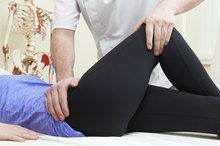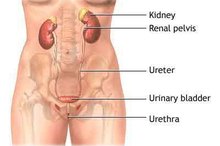Signs and Symptoms of a Pulled Groin Muscle in Women
**Whether you're running a 10k or taking a Zumba class, you risk a groin injury.
If you are experiencing serious medical symptoms, seek emergency treatment immediately.
** Pulled groin muscles are a common sports injury occurring most often in activities that involve running, jumping or changing direction. Symptoms of a groin strain in females include pain, tenderness and swelling; however, other health conditions can also cause the same symptoms 2.
Tips
A pulled groin muscle causes pain, swelling and sometimes a loss of muscle strength or function.
What Is a Pulled Groin Muscle?
A muscle pull, or strain, occurs when muscle fibers become overstretched or torn 12. These are the muscles that help bring the legs together. According to PhysioWorks, the most commonly injured muscle in the group is the adductor longus 23.
Symptoms of a Groin Strain
Swimming for Hip Flexor Injuries
Learn More
A pulled groin muscle is an acute injury, meaning it happens due to a specific traumatic event.
This is different than an overuse injury or tendinitis, which develop over time. However, each can contribute to the occurrence of the other.
Because it is acute, it's likely that you're aware when the injury happened. Perhaps you were attempting to do the splits or going for a soccer goal when all of a sudden, you felt a sharp pain in your groin. The pain may have been mild or very intense, and you may or may not have felt a snapping sensation or heard a popping noise that indicates a complete tear.
After the injury, you may also experience one or more of these symptoms:
- Muscle weakness
- Loss of muscle function
- Swelling
- Bruising
- Muscle spasm
- Muscle tightness
With a mild strain, you might only feel the pain momentarily 2. After the injury, it might only be noticeable when performing certain activities.
If your groin injury is more moderate, it may be painful to open and close your legs or raise your knee. The pain may radiate down the inside of your thigh as well. Severe injuries will make it painful to do almost any activity involving the lower body.
Read more: How to Strengthen the Lower Abdomen & Groin
- A pulled groin muscle is an acute injury, meaning it happens due to a specific traumatic event.
Getting a Diagnosis
Muscle strains are categorized according to their severity and symptoms:
Grade I is a mild strain only affecting a few muscle fibers. It is not very painful and does not limit muscle function.
Grade II is a moderate strain affecting more muscle fibers. There is more pain, swelling and potential bruising, and there may be a loss of muscle strength.
Grade III is a serious strain potentially involving a complete tear. The pain is severe and there is a complete loss of muscle function.
A grade I strain does not require medical attention. Grade II strains should be seen by a medical professional, and grade III strains require immediate medical care.
Your doctor will perform tests to determine the severity of your injury and whether a visit to a specialist is necessary. In all cases, the immediate treatment will involve reducing pain, swelling and bruising by resting the groin muscles, applying ice and possibly compression with an elastic bandage 2.
- Muscle strains are categorized according to their severity and symptoms: Grade I is a mild strain only affecting a few muscle fibers.
- Grade II is a moderate strain affecting more muscle fibers.
Is Ia Groin Strain?
Groin & Hip Pain Upon Standing & Walking
Learn More
The most common cause of groin pain is soft tissue strain, according to [WebMD.
](https://www.webmd.com/men/my-groin-hurt#2) However, there are several other reasons for groin pain in females, and the signs and symptoms can be similar to a strain. If you distinctly remember the event that caused your groin symptoms, then it's most likely a pull or another type of acute injury. However, if the initial occurrence of the pain is less distinct and it seems to have come on gradually, it could be something else.
Overuse injury: Overuse injuries and strains are often grouped together.
While strains are typically acute, overuse injuries occur gradually from repetitive motion and stress on the soft tissue. Overuse injuries can cause the groin muscles to weaken, which can then lead to an acute tear.
Pelvic fracture: According to Cedars-Sinai, the primary symptom of a fractured pelvis is groin pain 5. In addition, you may have pain in the hip or lower back that worsens with walking.
Labral tear: The labrum is a crescent-shaped structure composed of cartilage that extends along the edge of the hip socket. It provides cushioning and stability to the hip joint. Wear or tear from overuse or an acute injury can cause a labral tear, the most marked symptom of which is deep groin pain. According to the Hospital for Special Surgery, there may also be a sensation of clicking or locking in the hip 6.
Inguinal hernia: This type of hernia involves fat or part of the intestine breaking through the lower abdominal muscles. In addition to groin pain, there may be a visible bulge in your groin.
Hip bursitis: Bursa are fluid-filled sacs that provide cushioning and reduce friction between tissues, such as between tendon and bone. When these sacs become inflamed — typically due to repetitive motions, acute injury, infection or rheumatoid conditions, they can cause a condition called bursitis.
The largest bursa in the body is the iliopsoas bursa of the hip joint, according to MedicineNet 7. Hip bursitis is usually caused by injury — often from running — or arthritis. Besides groin tenderness, there may be pain that radiates down the thigh to the knee; the pain may be made worse by extension and rotation of the hip.
Femoroacetabular impingement: FAI occurs when there is extra bone growth along the bones of the hip joint 8. This gives an irregular shape to the bones, causing them to rub against each other during movement.
Over time, this causes injury to the hip joint. A common symptom of FAI is groin pain, but there may also be pain in the outer hip. The pain may be sharpest when turning, twisting or squatting.
Kidney stones: This painful condition is caused by the formation of firm deposits of minerals in your kidneys 9.
Read more: Exercises for Pulled Groin Muscles
- The most common cause of groin pain is soft tissue strain, according to [WebMD.
- ]( In addition, you may have pain in the hip or lower back that worsens with walking.
- Hip bursitis: Bursa are fluid-filled sacs that provide cushioning and reduce friction between tissues, such as between tendon and bone.
Related Articles
References
- WebMD: Groin Pull
- PhysioWorks: Groin Strain
- WebMD: Why Does My Groin Hurt?
- Cedars-Sinai: Pelvic Fracture
- Hospital for Special Surgery: Labral Tears of the Hip
- MedicineNet: Bursitis
- OrthoInfo: Femoroacetabular Impingement
- Mayo Clinic: Kidney stones
- Suarez JC, Ely EE, Mutnal AB, Figueroa NM, Klika AK, Patel PD, Barsoum WK. "Comprehensive approach to the evaluation of groin pain" J Am Acad Orthop Surg. 2013 Sep;21(9):558-70.
- Lynch TS, Bedi A, Larson CM. "Athletic Hip Injuries" J Am Acad Orthop Surg. 2017 Apr;25(4):269-279.
Writer Bio
Jody Braverman is a professional writer and editor based in Atlanta. She studied creative writing at the American University of Paris and received a Bachelor of Arts in English from the University of Maryland. She also received personal trainer certification from NASM and her 200-hour yoga teacher certification from YogaWorks.








